An Energy-Efficient UWB Transmitter with Wireless Injection Locking for RF Energy-Harvesting Sensors
Abstract
1. Introduction
2. Proposed RF Clock Harvester Design
3. Proposed UWB Transmitter Design
3.1. UWB Pulse Generator
3.2. Drive Amplifier
4. Results and Discussion
5. Conclusions
Author Contributions
Funding
Acknowledgments
Conflicts of Interest
References
- Saurav, B.; Anantha, P.C. Platform Architecture for Solar, Thermal, and Vibration Energy Combining with MPPT and Single Inductor. IEEE J. Solid-State Circuits 2012, 47, 2199–2215. [Google Scholar] [CrossRef]
- Shuo, L.; Abhishek, R.; Benton, H.C. A Piezoelectric Energy-Harvesting System with Parallel-SSHI Rectifier and Integrated MPPT Achieving 417% Energy-Extraction Improvement and 97% Tracking Efficiency. In Proceedings of the 2019 Symposium on VLSI Circuits, Kyoto, Japan, 9–14 June 2019. [Google Scholar] [CrossRef]
- Akshay, P.; Mayur, J.; Shreyas, J.; Elton, B.; Apurva, V. Energy Harvesting using Piezoelectricity. In Proceedings of the 2015 IEEE International Conference Energy Systems and Applications, Pune, India, 30 October–1 November 2015. [Google Scholar] [CrossRef]
- Park, I.; Maeng, J.; Shim, M.; Jeong, J.; Kim, C. A Bidirectional High-Voltage Dual-Input Buck Converter for Triboelectric Energy-Harvesting Interface Achieving 70.72% End-to-End Efficiency. In Proceedings of the 2019 Symposium on VLSI Circuits IEEE, Kyoto, Japan, 9–14 June 2019. [Google Scholar]
- Tolga, S.; Lucian, C.; Wendi, H. RF Energy Harvesting for Embedded Systems: A Survey of Tradeoffs and Methodology. Circ. Sys. Mag. 2016, 16, 22–57. [Google Scholar] [CrossRef]
- Muhammad, P.K.P.; Mohammad, S.A.; Achmad, M. Circular Waveguide Array for Radio Frequency Energy Harvesting. In Proceedings of the 2018 12th International Conference on Telecommunication Systems, Services, and Applications (TSSA), Yogyakarta, Indonesia, 4–5 October 2018. [Google Scholar] [CrossRef]
- Sumit, B.; Suresh, B. Green Energy Harvesting Using Piezoelectric Materials from Bridge Vibrations. In Proceedings of the 2018 2nd International Conference on Green Energy and Applications (ICGEA), Singapore, Singapore, 24–26 March 2018. [Google Scholar]
- Zakariya, M.D. Energy Harvesting using Thermoelectric Generators. In Proceedings of the 2016 IEEE International Energy Conference (ENERGYCON), Leuven, Belgium, 4–8 April 2016. [Google Scholar] [CrossRef]
- Oktay, C.; Ozgur, B.A. Electric-Field Energy Harvesting from Lighting Elements for Battery-Less Internet of Things. IEEE Access 2017, 5, 1–12. [Google Scholar] [CrossRef]
- Maria, G.; John, S.; Guy, G.; Mina, C.; Ioannis, K.; Gil, Z. Movers and shakers: Kinetic energy harvesting for the Internet of things. J. Sel. Areas Commun. 2015, 33, 1624–1639. [Google Scholar] [CrossRef]
- Bander, A.; Waleed, E. Resource management for cognitive IoT systems with RF energy harvesting in smart cities. IEEE Access 2018, 6, 62717–62727. [Google Scholar] [CrossRef]
- Ercan, A.Ö.; Sunay, M.O.; Akyildiz, I.F. RF energy harvesting and transfer for spectrum sharing cellular IoT communications in 5G systems. IEEE Trans. Mob. Comput. 2018, 17, 1680–1694. [Google Scholar] [CrossRef]
- Ken, M.; Tsutomu, N.; Yoshinobu, K.; Hidenori, M.; Hiroshi, S.; Takashi, I.; Yasunobu, A.; Keiichi, M.; Hideaki, Y.; Takashi, I.; et al. A 65nm Silicon-on-Thin-Box (SOTB) Embedded 2T-MONOS Flash Achieving 0.22 pJ/bit Read Energy with 64 MHz Access for IoT Applications. In Proceedings of the 2019 Symposium on VLSI Circuits, Kyoto, Japan, 9–14 June 2019. [Google Scholar] [CrossRef]
- Lee, Y.; Bang, S.; Lee, I.; Kim, Y.; Kim, G.; Mohammad, H.G.; Pat, P.; Prabal, D.; Dennis, S.; David, B. IEEE A modular 1 mm3 die-stacked sensing platform with low power I2C inter-die communication and multi-modal energy harvesting. IEEE J. Solid-State Circuits 2013, 48, 229–243. [Google Scholar] [CrossRef]
- Hrishikesh, J.; Lee, K.; Lee, W.S.; Arnab, R.; Kim, Y.; Vijay, R. Powering the internet of things. In Proceedings of the 2014 international Symposium Low Power Electronics and Design (ISLPED), La Jolla, CA, USA, 11–13 August 2014. [Google Scholar] [CrossRef]
- Mao, J.; Zou, Z.; Zheng, L.R. A Subgigahertz UWB Transmitter with Wireless Clock Harvesting for RF Powered Applications. IEEE Trans. Circuits Syst. 2014, 61, 314–318. [Google Scholar] [CrossRef]
- Michael, Y.; Alireza, Z.; Behnam, M.; Hooman, D.; Asad, A.A. A low-power GSM/EDGE/WCDMA polar transmitter in 65-nm CMOS. Ieee J. Solid-State Circuits 2011, 46, 3061–3074. [Google Scholar] [CrossRef]
- Behzad, R. A study of injection locking and pulling in oscillator. IEEE J. Solid-State Circuits 2004, 39, 1415–1424. [Google Scholar] [CrossRef]
- Paolo, M. Analysis of oscillator injection locking through phase domain impulse-response. IEEE Trans. Circuits Syst. I Regul. Pap. 2015, 55, 1297–1305. [Google Scholar] [CrossRef]
- Dustin, D.; Anthony, C.C. Modeling oscillator injection locking using the phase domain response. IEEE Trans. Circuits Syst. I Regul. Pap. 2013, 60, 2823–2833. [Google Scholar] [CrossRef]
- Stefano, D.T.; Andrea, B.; Marc, T.; Nicola, D.D.; Andrea, G.; Andrea, N. An integrated divide-by-two direct injection locking frequency divider for bands S through Ku. Ieee Trans. Microw. Theory Tech. 2010, 58, 1686–1695. [Google Scholar] [CrossRef]
- Yi, X.; Boon, C.C.; Do, M.A.; Yeo, K.S.; Lim, W.M. Design of ring-oscillator-based injection-locked frequency dividers with single phase inputs. IEEE Microw. Wirel. Compon. Lett. 2011, 21, 559–561. [Google Scholar] [CrossRef]
- Ahmed, M.; Kenichi, O.; Akira, M. Progressive mixing technique to widen the locking range of high division-ratio injec-tion-locked frequency dividers. IEEE Trans. Microw. Theory Tech. 2013, 61, 1161–1173. [Google Scholar] [CrossRef]
- Abderrahmane, H.; Remy, V.; Nicolas, D.; Jean, G. A Fully Digital Ultra-wide Band Sub-GHz Pulse Generator. In Proceedings of the 2017 15th IEEE International New Circuits and Systems Conference (NEWCAS), Strasbourg, France, 25–28 June 2017. [Google Scholar] [CrossRef]
- Na, K.; Jang, H.; Ma, H.; Choi, Y.; Bien, F. A 200-Mb/s Data Rate 3.1–4.8-GHz IR-UWB All-Digital Pulse Generator With DB-BPSK Modulation. IEEE Trans. Circuits Syst. II Express Briefs 2015, 62, 1184–1188. [Google Scholar] [CrossRef]
- Yoo, H.J.; Park, M.C.; Kwon, I.; Eo, Y.S. A tunable ultrawideband digital impulse generator in 0.18 μm CMOS. Microw. Opt. Technol. Lett. 2015, 57, 865–868. [Google Scholar] [CrossRef]
- Choi, J.; Kwon, I. CMOS impulse radio ultra-wideband Gaussian pulse generator with variable channel and bandwidth. IET Circuits Devices Syst. 2016, 10, 135–139. [Google Scholar] [CrossRef]
- Kim, W.; Kwon, I. CMOS pulse generator based on spectral efficiently gated oscillator for UWB impulse radio. IEICE Electron. Express 2013, 10, 20130204. [Google Scholar] [CrossRef][Green Version]
- Wang, X.; Dinh, A.; Teng, D. 3–10 GHz ultra wideband front-end transceiver in 0.13 μm complementary metal oxide semi-conductor for low-power biomedical radar. IET Circuits Devices Syst. 2014, 8, 272–279. [Google Scholar] [CrossRef]
- Batur, O.Z.; Akdag, E.; Akkurt, H.K.; Oncu, A.; Koca, M.; Dundar, G. An Ultra Low-Power Dual-Band IR-UWB Transmitter in 130-nm CMOS. IEEE Trans. Circuits Syst. II Express Briefs 2012, 59, 701–705. [Google Scholar] [CrossRef]
- Aidin, T.; Ali, J. An efficient method to analyze lock range in ring oscillators with multiple injections. IEEE Trans. Circuits Syst. II Express Briefs 2015, 62, 1013–1017. [Google Scholar] [CrossRef]
- Tang, N.L.; Yi, J.E.C. A 0.8-mW 55-GHz dual-injection-locked CMOS frequency divider. IEEE Trans. Microw. Theory Tech. 2008, 56, 620–625. [Google Scholar] [CrossRef]
- Ahmad, M.; Mohammad, E.H.; Rahim, B.; Asad, A.A. Multi-phase injection widens lock range of ring-oscillator-based fre-quency dividers. IEEE J. Solid-State Circuits 2008, 43, 656–671. [Google Scholar] [CrossRef]
- Amr, A.H.; Chih, K.K.Y. Analysis and design of superharmonic injection-locked multipath ring oscillators. IEEE Trans. Circuits Syst. I Regul. Pap. 2013, 60, 1712–1725. [Google Scholar] [CrossRef]
- Aidin, T.; Armin, T.; Namdar, S. Strong injection locking and pulling in LC multiphase oscillator with multiple injection signal. IEEE Trans. Circuits Syst. II Express Briefs 2019, 66, 1336–1340. [Google Scholar] [CrossRef]
- Liu, S.; Zheng, Y.; Lim, W.M.; Yang, W. Ring oscillator based injection locked frequency divider using dual injection paths. IEEE Microw. Wirel. Compon. Lett. 2015, 25, 322–324. [Google Scholar] [CrossRef]
- Ali, R.H.; Hossein, M.N. Generalized analytical equations for injected ring oscillator with RC-load. IEEE Trans. Circuits Syst. I Regul. Pap. 2018, 65, 223–234. [Google Scholar] [CrossRef]
- Lee, D.S.; Jang, J.H.; Park, H.G.; Pu, Y.G.; Hwang, K.G.; Yang, Y.; Seo, M.K.; Lee, K.Y. A Wide-Locking Range Dual Injection-Locked Frequency Divider with An Automatic Frequency Calibration Loop in 65-nm CMOS. IEEE Trans. Circuits Syst. II Express Briefs 2015, 62, 327–331. [Google Scholar] [CrossRef]
- Mingze, L.; Ralph, D.M.; Nahla, T.A.E.K. A fully synthesized injection locked ring oscillator based on a pulse injection locking technique. In Proceedings of the IEEE Asia Pacific Microwave Conference (APMC), Kuala Lumpar, Malaysia, 13–16 November 2017. [Google Scholar] [CrossRef]
- Lin, Y.H.; Wang, H. Design and analysis of W-band injection-locked frequency divider using split transformer coupled oscillator technique. IEEE Trans. Microw. Theory Tech. 2018, 66, 177–186. [Google Scholar] [CrossRef]
- Ken, Y.; Minoru, F. A 44-μW 4.3-GHz Injection-Locked Frequency Divider with 2.3-GHz Locking Range. IEEE J. Solid-State Circuits 2005, 40, 671–677. [Google Scholar] [CrossRef]
- Prezemyslaw, M.; Piotr, D. Tunable CMOS Delay Gate with Improved Matching Properties. IEEE Trans. Circuits Syst. I Regul. Pap. 2014, 61, 2586–2595. [Google Scholar] [CrossRef]
- Bao, D.; Zou, Z.; Nejad, M.B.; Qin, Y.; Zheng, L.R. A Wirelessly Powered UWB RFID Sensor Tag with Time-Domain Analog-to-Information Interface. IEEE J. Solid-State Circuits 2018, 53, 2227–2239. [Google Scholar] [CrossRef]
- Chen, F.; Li, Y.; Liu, D.; Rhee, W.; Kim, J.; Kim, D.; Wang, Z. 9.3 A 1 mW 1Mb/s 7.75-to-8.25GHz chirp-UWB transceiver with low peak-power transmission and fast synchronization capability. In Proceedings of the 2014 IEEE International Solid-State Circuits Conference Digest of Technical Papers (ISSCC), San Francisco, CA, USA, 9–13 February 2014. [Google Scholar]
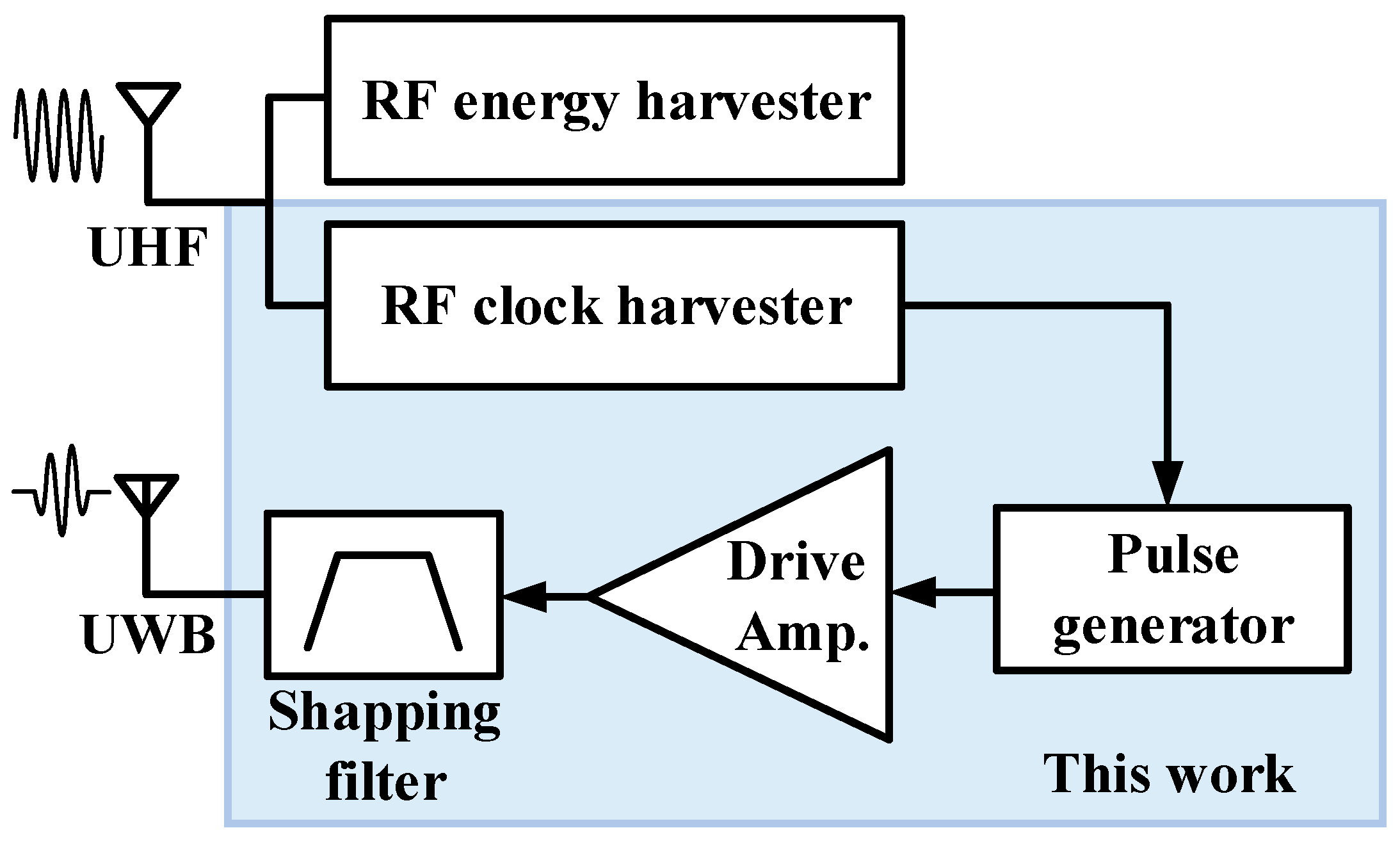
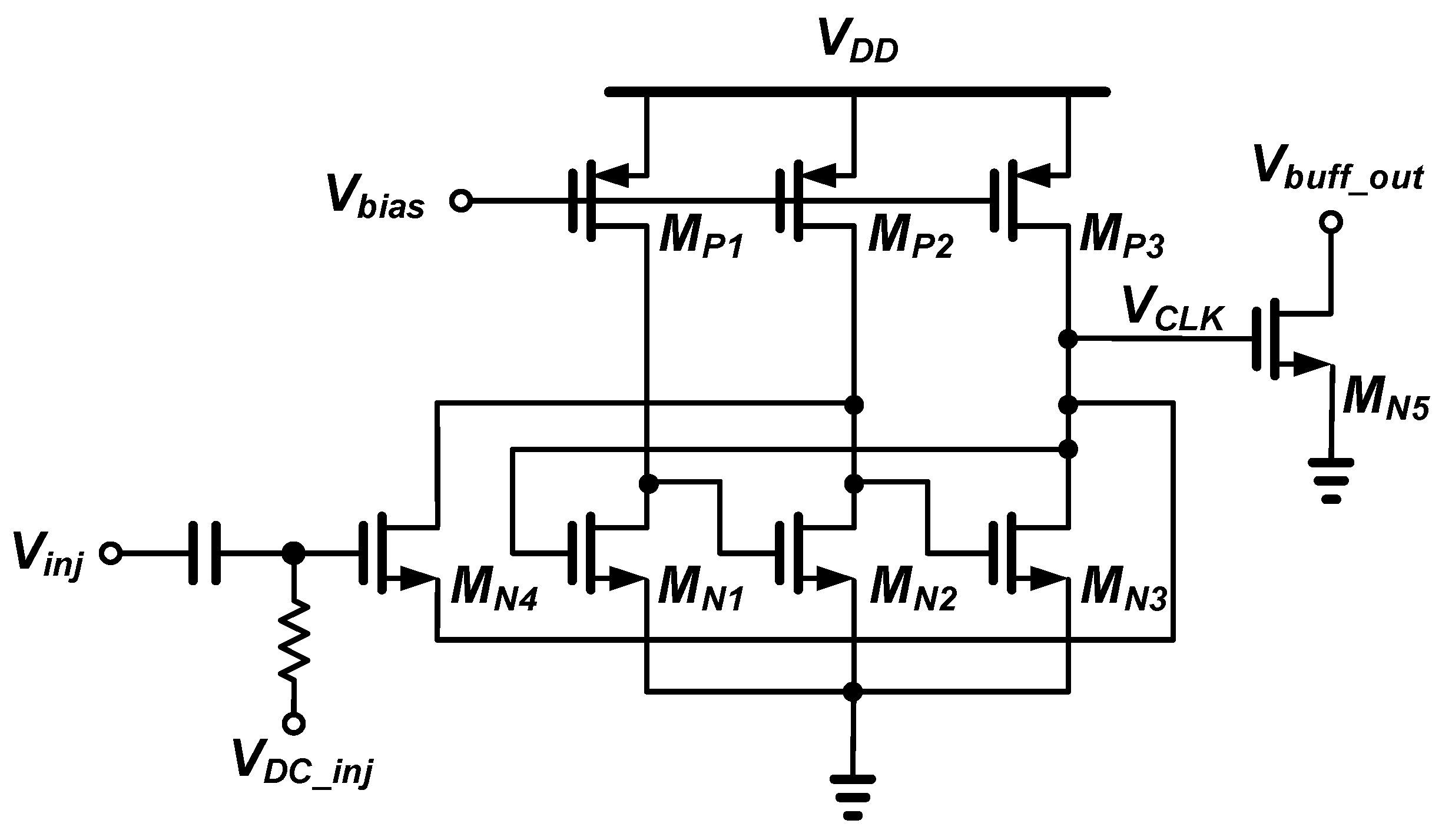

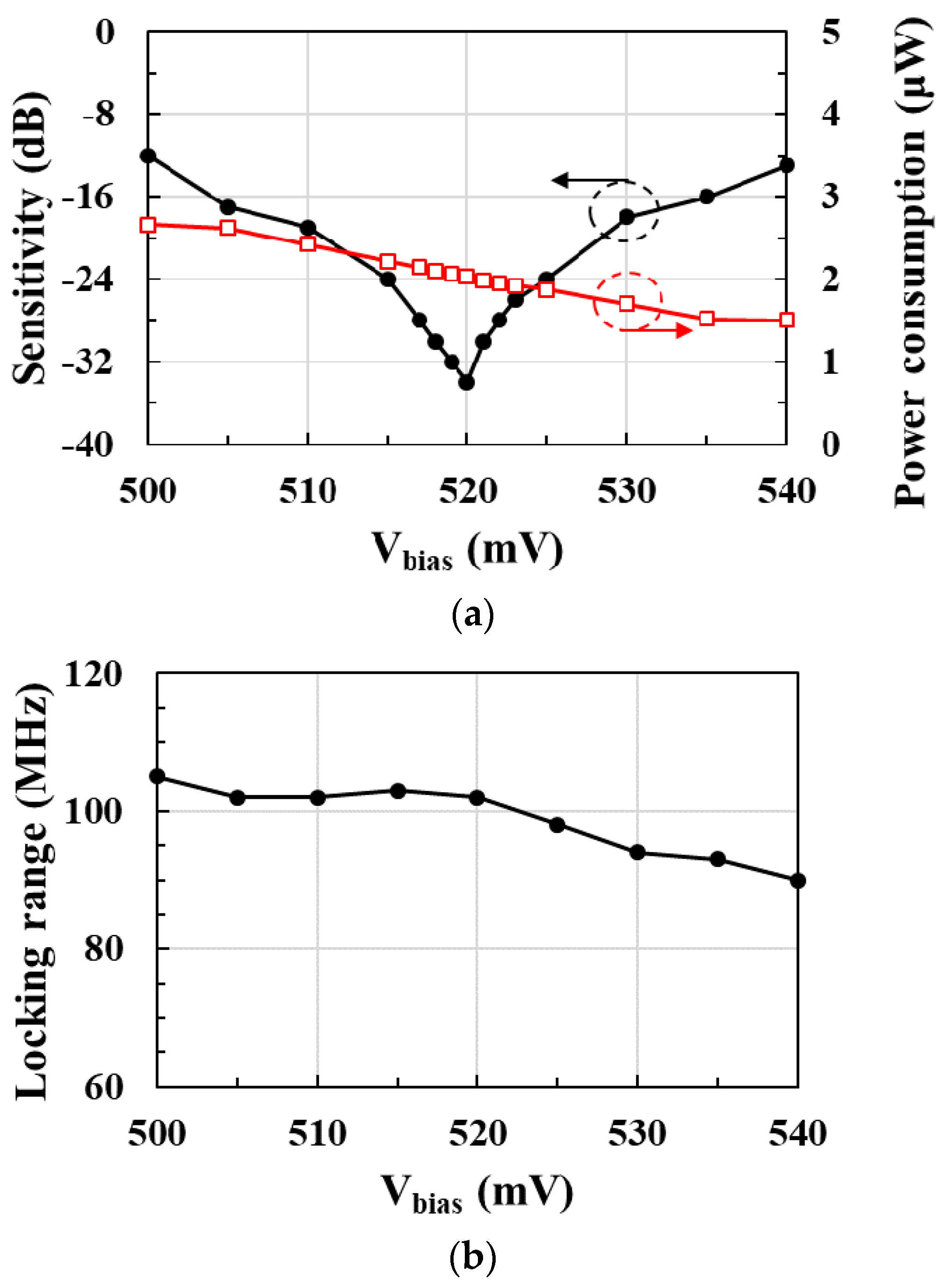


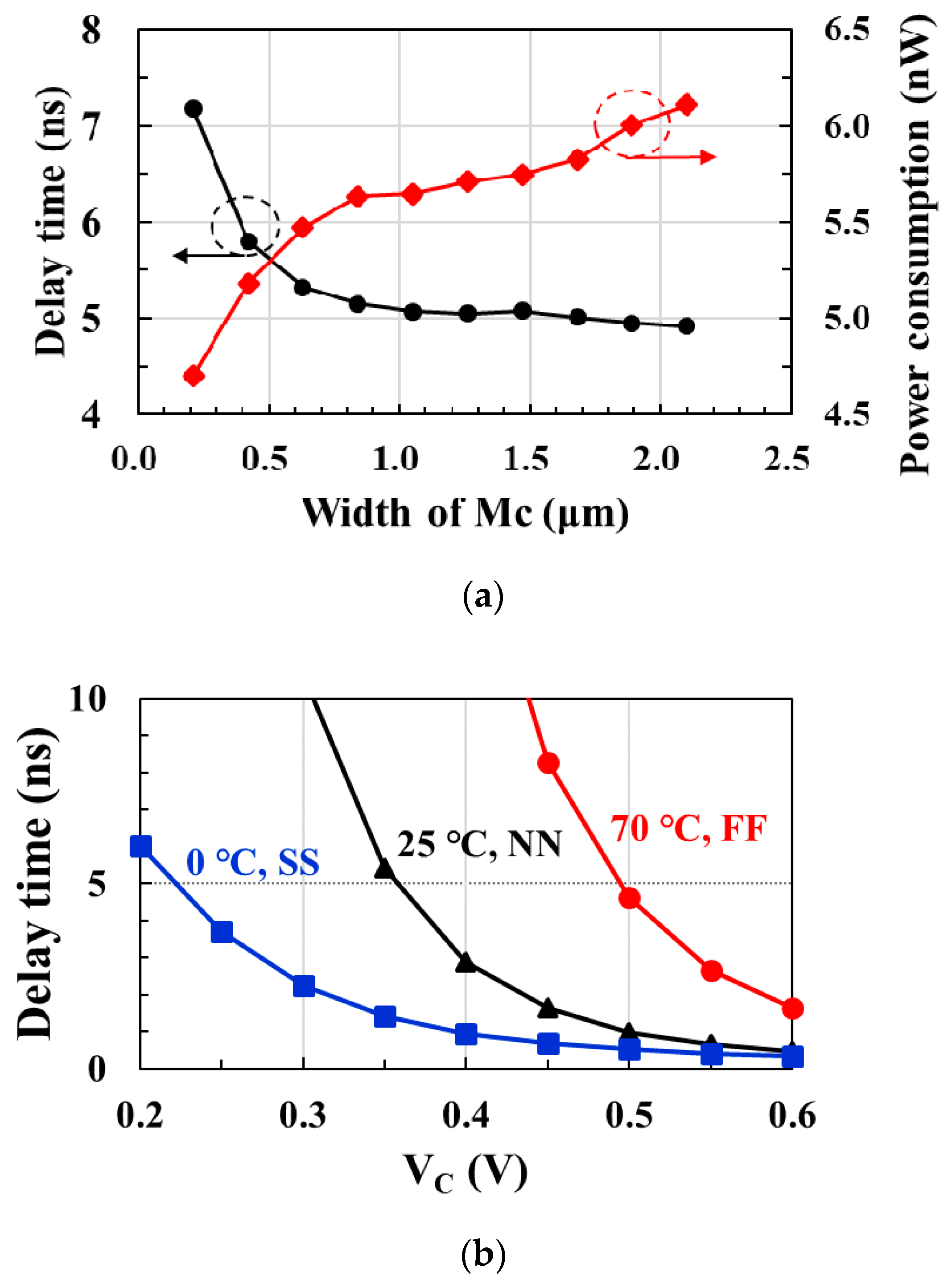
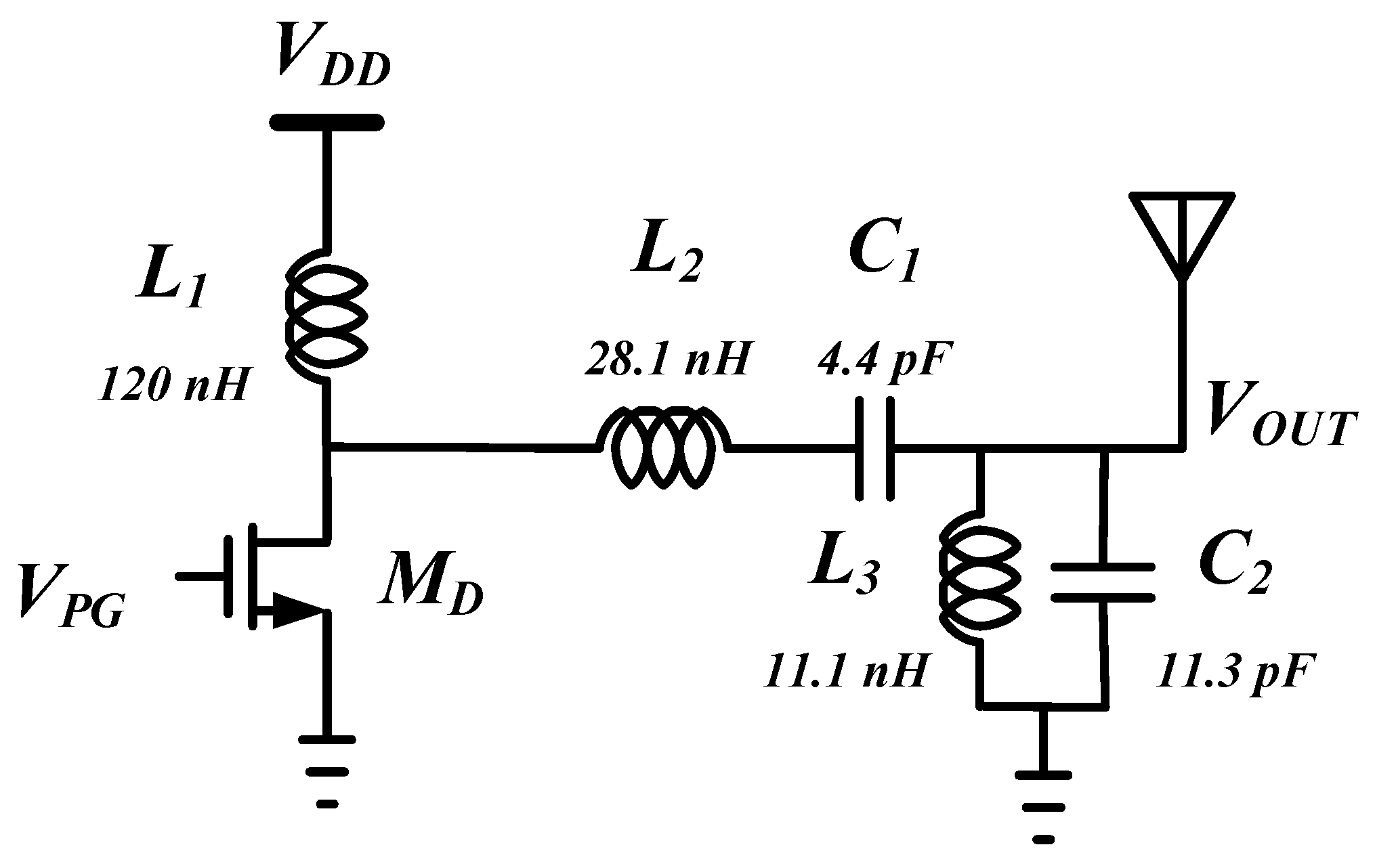
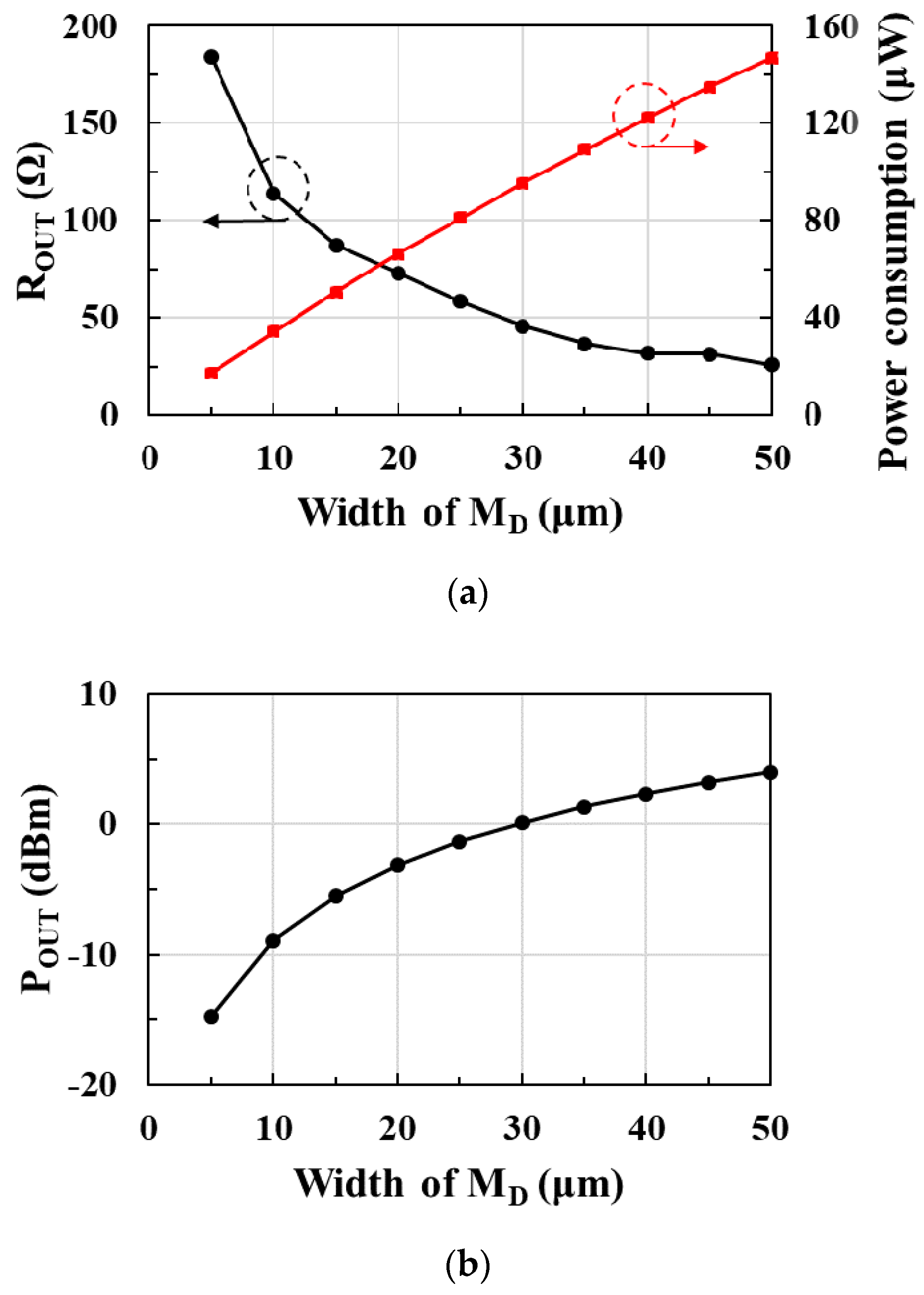


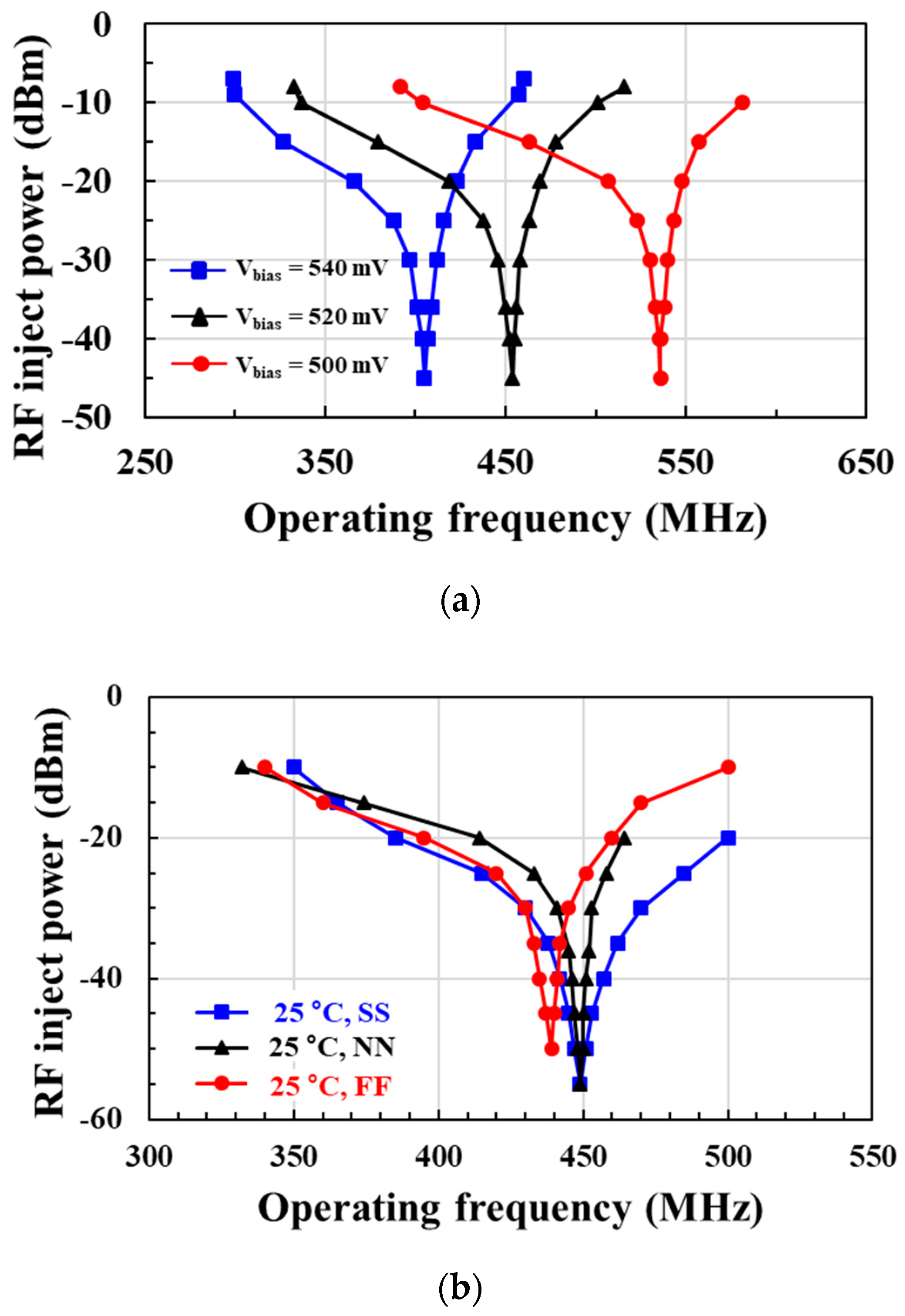


| Reference | [16] | [24] | [43] | [44] | This Work |
|---|---|---|---|---|---|
| CMOS process (nm) | 180 | 130 | 180 | 65 | 65 |
| Supply (V) | 1 | 1.2 | 1.8 | 1 | 1 |
| Sampling rate (MHz) | 5 | 100 | 0.3 | 1 | 5 |
| UWB band (MHz) | 400 @fC = 450 | 629.8 @fC = 496 | 5000 @fC = 5500 | 4000 @fC = 8000 | 415 @fC = 450 |
| Output swing (VPP) | 0.75 | 0.9 | 0.35 | 0.12 | 0.77 |
| Power Consumption (μW) | 175 | 2700 | 11.62 | 300 | 97.03 |
| Energy/pulse (pJ/pulse) | 35 | 27 | 38 | 300 | 19.41 |
Publisher’s Note: MDPI stays neutral with regard to jurisdictional claims in published maps and institutional affiliations. |
© 2021 by the authors. Licensee MDPI, Basel, Switzerland. This article is an open access article distributed under the terms and conditions of the Creative Commons Attribution (CC BY) license (http://creativecommons.org/licenses/by/4.0/).
Share and Cite
Kim, J.-T.; Heo, B.-R.; Kwon, I. An Energy-Efficient UWB Transmitter with Wireless Injection Locking for RF Energy-Harvesting Sensors. Sensors 2021, 21, 1426. https://doi.org/10.3390/s21041426
Kim J-T, Heo B-R, Kwon I. An Energy-Efficient UWB Transmitter with Wireless Injection Locking for RF Energy-Harvesting Sensors. Sensors. 2021; 21(4):1426. https://doi.org/10.3390/s21041426
Chicago/Turabian StyleKim, Jun-Tae, Bo-Ram Heo, and Ickjin Kwon. 2021. "An Energy-Efficient UWB Transmitter with Wireless Injection Locking for RF Energy-Harvesting Sensors" Sensors 21, no. 4: 1426. https://doi.org/10.3390/s21041426
APA StyleKim, J.-T., Heo, B.-R., & Kwon, I. (2021). An Energy-Efficient UWB Transmitter with Wireless Injection Locking for RF Energy-Harvesting Sensors. Sensors, 21(4), 1426. https://doi.org/10.3390/s21041426








